BMW i3 94Ah Range Extender - Suite (A) Review
23 Nov 2017|11,663 views
What We Like
Same old unique exterior and interior design
Cabin is spacious
More range, which means improved practicality
Fun to drive
What We Dislike
While BMW is helping to improve charging infrastructure, Singapore still has a long way to go before electric vehicles and fully accepted
When BMW launched the i3 in 2013 under its BMW i sub-brand, the futuristic eco box was a revolution. Driven sensibly, the original BMW i3 had almost 190km of electric range, an optional range extender, which increased a theoretical 140km to the car's total range and was made almost entirely of carbon fibre.
However, as the Electric Vehicle (EV) scene advanced, the 190km pure electric range of the i3 wasn't very competitive anymore. On top of that, the severe lack of charging infrastructure in Singapore meant not many car owners here were comfortable giving one a shot.
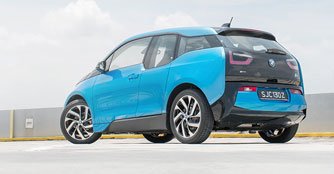
 The BMW i3 now has a new lithium-ion 33kWh battery, which increases electric range by over 50 percent
The BMW i3 now has a new lithium-ion 33kWh battery, which increases electric range by over 50 percent
As such, BMW i has given the i3 a minor but much desired update comprising a new battery, which increases the car's electric range by a notable distance, helping solve whatever range anxiety issues prospective owners may face.
More range, less woe
The BMW i3 now packs a longer-range lithium-ion 33kWh battery, made possible by the higher storage density of the lithium-ion cells. With 167bhp and 250Nm of immediate torque available at the calling of your right foot, the car does feel quicker accelerating from 0-100km/h than the official published timing of 8.1 seconds.
Even as a non-believer of electric cars, it's hard not to childishly giggle at how the BMW i3 manages to propel itself way ahead of everything else when the lights turn green, in total silence no less.
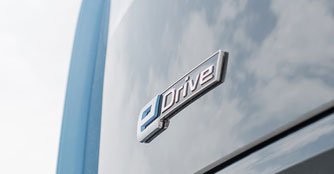
 BMW's innovative eDrive system gifts the i3 with 250Nm of immediate torque for easy acceleration and overtaking
BMW's innovative eDrive system gifts the i3 with 250Nm of immediate torque for easy acceleration and overtaking
Rocketing past an unsuspecting road-hogger is even more fun. Due to the nature of the powertrain, there is zero lag; no need for combustion to take place, or for a turbocharger to spool.
More importantly, you can now travel further without worrying about recharging. With the new battery, the car's electric range has increased over 50 percent from approximately 190km to almost 370km, backed up by the range extender, codenamed REx.
A little getting used to, though...
While the improvements to the car's range mean usability is greatly improved, the BMW i3 does take some getting used to as an everyday car.
For example, first-timers can get confused as to whether they've started the car, as there isn't a crank-up sound. Instead, with your foot on the brake, the only indication that the car is ready to roll is a blue glow on the steering-mounted drive mode selector and the digital cluster displaying 'Ready'.
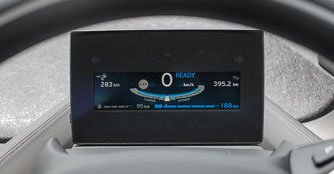
 Although the car starts up in silence, the digital instrument cluster lets you know it's ready to rock by displaying 'Ready'
Although the car starts up in silence, the digital instrument cluster lets you know it's ready to rock by displaying 'Ready'
The car's regenerative braking system is another characteristic that may catch new owners off guard. Unlike petrol, diesel or hybrid cars, which cruise when you let off the gas, the BMW i3 has a strong regenerative braking system that slows the car down without much need for employing the brakes.
It's best to ease off the gas to control the reduction in speed, as opposed to just taking your foot off.
However, as the Electric Vehicle (EV) scene advanced, the 190km pure electric range of the i3 wasn't very competitive anymore. On top of that, the severe lack of charging infrastructure in Singapore meant not many car owners here were comfortable giving one a shot.

As such, BMW i has given the i3 a minor but much desired update comprising a new battery, which increases the car's electric range by a notable distance, helping solve whatever range anxiety issues prospective owners may face.
More range, less woe
The BMW i3 now packs a longer-range lithium-ion 33kWh battery, made possible by the higher storage density of the lithium-ion cells. With 167bhp and 250Nm of immediate torque available at the calling of your right foot, the car does feel quicker accelerating from 0-100km/h than the official published timing of 8.1 seconds.
Even as a non-believer of electric cars, it's hard not to childishly giggle at how the BMW i3 manages to propel itself way ahead of everything else when the lights turn green, in total silence no less.

Rocketing past an unsuspecting road-hogger is even more fun. Due to the nature of the powertrain, there is zero lag; no need for combustion to take place, or for a turbocharger to spool.
More importantly, you can now travel further without worrying about recharging. With the new battery, the car's electric range has increased over 50 percent from approximately 190km to almost 370km, backed up by the range extender, codenamed REx.
A little getting used to, though...
While the improvements to the car's range mean usability is greatly improved, the BMW i3 does take some getting used to as an everyday car.
For example, first-timers can get confused as to whether they've started the car, as there isn't a crank-up sound. Instead, with your foot on the brake, the only indication that the car is ready to roll is a blue glow on the steering-mounted drive mode selector and the digital cluster displaying 'Ready'.

The car's regenerative braking system is another characteristic that may catch new owners off guard. Unlike petrol, diesel or hybrid cars, which cruise when you let off the gas, the BMW i3 has a strong regenerative braking system that slows the car down without much need for employing the brakes.
It's best to ease off the gas to control the reduction in speed, as opposed to just taking your foot off.
Given its boxy shape, you wouldn't expect the BMW i3 to be associated with words like 'zippy', which is why we were in for a pleasant surprise when even the slightest steering input translated into very quick and precise directional changes. But don't expect it to behave like a hot hatch because its skinny eco tyres do have some trouble keeping up when driven harder.
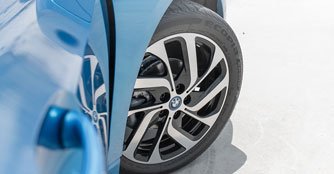
 The skinny eco tyres' low rolling resistance help with the range but have some trouble keeping up when driven hard
The skinny eco tyres' low rolling resistance help with the range but have some trouble keeping up when driven hard
Needless to say, manoeuvring around town and tight parking spaces is easy, thanks to the car's small footprint.
Glasshouse specialty
Although the BMW i3 is just under 4m-long, it's surprisingly spacious on the inside, thanks to its clever glasshouse design. As a result, it's very easy to see out of it.
As expected of BMW, fit and finish feel premium and the use of wood trims hint at Scandinavian-inspired elements. Entry into the rear is via a rear-hinged door, akin to the Mazda RX-8, and it works well. Accomodation at the back, however, is best left for two and for short city drives.
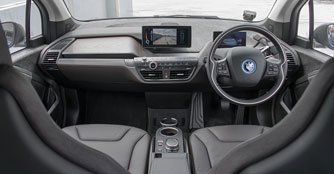
 The cabin of the BMW i3 is airy, well-lit and spacious, which complements the Scandinavian-inspired elements well
The cabin of the BMW i3 is airy, well-lit and spacious, which complements the Scandinavian-inspired elements well
Ownership made easier
With the introduction of this BMW i3, BMW i will be offering a new BMW i Wallbox for comfortable and fast home garage charging or charging on a private parking space. BMW i also provides a unique installation service including onsite installation assessment at the customer's, the supply and installation of the charging station as well as maintenance, consulting and other services.
BMW Asia is also working with Greenlots to build up the charging infrastructure in Singapore. There are currently 60 public EV charging stations at 37 locations spread across the island. Drivers can locate the charging stations nearest to them within the ChargeNow network quickly and easily by making use of BMW ConnectedDrive Services in their vehicle's navigation system for real-time status, pricing information and turn-by-turn directions.
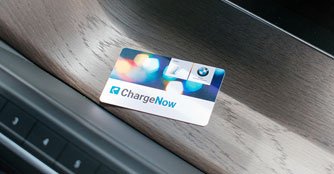
 With ChargeNow, BMW i and iPerformance drivers have easy access to public charging stations located across Singapore
With ChargeNow, BMW i and iPerformance drivers have easy access to public charging stations located across Singapore
Undoubtedly, even with the push towards a greener motoring landscape and the initiatives of BMW here in Singapore, acceptance of EVs will take at least a decade more. After all, most Singaporeans live in public housing and as to how well-taken care of or available public charging stations will be in the future - that remains to be answered.
And are car owners ready to give up petrol cars for electrics? Many like myself may still say no, but when the time comes, we can take comfort in knowing that companies like BMW are improving products like the BMW i3. It's probably the best option for an EV if you're an urban commuter or inner-city dweller.

Needless to say, manoeuvring around town and tight parking spaces is easy, thanks to the car's small footprint.
Glasshouse specialty
Although the BMW i3 is just under 4m-long, it's surprisingly spacious on the inside, thanks to its clever glasshouse design. As a result, it's very easy to see out of it.
As expected of BMW, fit and finish feel premium and the use of wood trims hint at Scandinavian-inspired elements. Entry into the rear is via a rear-hinged door, akin to the Mazda RX-8, and it works well. Accomodation at the back, however, is best left for two and for short city drives.

Ownership made easier
With the introduction of this BMW i3, BMW i will be offering a new BMW i Wallbox for comfortable and fast home garage charging or charging on a private parking space. BMW i also provides a unique installation service including onsite installation assessment at the customer's, the supply and installation of the charging station as well as maintenance, consulting and other services.
BMW Asia is also working with Greenlots to build up the charging infrastructure in Singapore. There are currently 60 public EV charging stations at 37 locations spread across the island. Drivers can locate the charging stations nearest to them within the ChargeNow network quickly and easily by making use of BMW ConnectedDrive Services in their vehicle's navigation system for real-time status, pricing information and turn-by-turn directions.

Undoubtedly, even with the push towards a greener motoring landscape and the initiatives of BMW here in Singapore, acceptance of EVs will take at least a decade more. After all, most Singaporeans live in public housing and as to how well-taken care of or available public charging stations will be in the future - that remains to be answered.
And are car owners ready to give up petrol cars for electrics? Many like myself may still say no, but when the time comes, we can take comfort in knowing that companies like BMW are improving products like the BMW i3. It's probably the best option for an EV if you're an urban commuter or inner-city dweller.
What We Like
Same old unique exterior and interior design
Cabin is spacious
More range, which means improved practicality
Fun to drive
What We Dislike
While BMW is helping to improve charging infrastructure, Singapore still has a long way to go before electric vehicles and fully accepted
When BMW launched the i3 in 2013 under its BMW i sub-brand, the futuristic eco box was a revolution. Driven sensibly, the original BMW i3 had almost 190km of electric range, an optional range extender, which increased a theoretical 140km to the car's total range and was made almost entirely of carbon fibre.
However, as the Electric Vehicle (EV) scene advanced, the 190km pure electric range of the i3 wasn't very competitive anymore. On top of that, the severe lack of charging infrastructure in Singapore meant not many car owners here were comfortable giving one a shot.

 The BMW i3 now has a new lithium-ion 33kWh battery, which increases electric range by over 50 percentAs such, BMW i has given the i3 a minor but much desired update comprising a new battery, which increases the car's electric range by a notable distance, helping solve whatever range anxiety issues prospective owners may face.
The BMW i3 now has a new lithium-ion 33kWh battery, which increases electric range by over 50 percentAs such, BMW i has given the i3 a minor but much desired update comprising a new battery, which increases the car's electric range by a notable distance, helping solve whatever range anxiety issues prospective owners may face.
More range, less woe
The BMW i3 now packs a longer-range lithium-ion 33kWh battery, made possible by the higher storage density of the lithium-ion cells. With 167bhp and 250Nm of immediate torque available at the calling of your right foot, the car does feel quicker accelerating from 0-100km/h than the official published timing of 8.1 seconds.
Even as a non-believer of electric cars, it's hard not to childishly giggle at how the BMW i3 manages to propel itself way ahead of everything else when the lights turn green, in total silence no less.

 BMW's innovative eDrive system gifts the i3 with 250Nm of immediate torque for easy acceleration and overtakingRocketing past an unsuspecting road-hogger is even more fun. Due to the nature of the powertrain, there is zero lag; no need for combustion to take place, or for a turbocharger to spool.
BMW's innovative eDrive system gifts the i3 with 250Nm of immediate torque for easy acceleration and overtakingRocketing past an unsuspecting road-hogger is even more fun. Due to the nature of the powertrain, there is zero lag; no need for combustion to take place, or for a turbocharger to spool.
More importantly, you can now travel further without worrying about recharging. With the new battery, the car's electric range has increased over 50 percent from approximately 190km to almost 370km, backed up by the range extender, codenamed REx.
A little getting used to, though...
While the improvements to the car's range mean usability is greatly improved, the BMW i3 does take some getting used to as an everyday car.
For example, first-timers can get confused as to whether they've started the car, as there isn't a crank-up sound. Instead, with your foot on the brake, the only indication that the car is ready to roll is a blue glow on the steering-mounted drive mode selector and the digital cluster displaying 'Ready'.

 Although the car starts up in silence, the digital instrument cluster lets you know it's ready to rock by displaying 'Ready'The car's regenerative braking system is another characteristic that may catch new owners off guard. Unlike petrol, diesel or hybrid cars, which cruise when you let off the gas, the BMW i3 has a strong regenerative braking system that slows the car down without much need for employing the brakes.
Although the car starts up in silence, the digital instrument cluster lets you know it's ready to rock by displaying 'Ready'The car's regenerative braking system is another characteristic that may catch new owners off guard. Unlike petrol, diesel or hybrid cars, which cruise when you let off the gas, the BMW i3 has a strong regenerative braking system that slows the car down without much need for employing the brakes.
It's best to ease off the gas to control the reduction in speed, as opposed to just taking your foot off.
However, as the Electric Vehicle (EV) scene advanced, the 190km pure electric range of the i3 wasn't very competitive anymore. On top of that, the severe lack of charging infrastructure in Singapore meant not many car owners here were comfortable giving one a shot.

More range, less woe
The BMW i3 now packs a longer-range lithium-ion 33kWh battery, made possible by the higher storage density of the lithium-ion cells. With 167bhp and 250Nm of immediate torque available at the calling of your right foot, the car does feel quicker accelerating from 0-100km/h than the official published timing of 8.1 seconds.
Even as a non-believer of electric cars, it's hard not to childishly giggle at how the BMW i3 manages to propel itself way ahead of everything else when the lights turn green, in total silence no less.

More importantly, you can now travel further without worrying about recharging. With the new battery, the car's electric range has increased over 50 percent from approximately 190km to almost 370km, backed up by the range extender, codenamed REx.
A little getting used to, though...
While the improvements to the car's range mean usability is greatly improved, the BMW i3 does take some getting used to as an everyday car.
For example, first-timers can get confused as to whether they've started the car, as there isn't a crank-up sound. Instead, with your foot on the brake, the only indication that the car is ready to roll is a blue glow on the steering-mounted drive mode selector and the digital cluster displaying 'Ready'.

It's best to ease off the gas to control the reduction in speed, as opposed to just taking your foot off.
Given its boxy shape, you wouldn't expect the BMW i3 to be associated with words like 'zippy', which is why we were in for a pleasant surprise when even the slightest steering input translated into very quick and precise directional changes. But don't expect it to behave like a hot hatch because its skinny eco tyres do have some trouble keeping up when driven harder.

 The skinny eco tyres' low rolling resistance help with the range but have some trouble keeping up when driven hardNeedless to say, manoeuvring around town and tight parking spaces is easy, thanks to the car's small footprint.
The skinny eco tyres' low rolling resistance help with the range but have some trouble keeping up when driven hardNeedless to say, manoeuvring around town and tight parking spaces is easy, thanks to the car's small footprint.
Glasshouse specialty
Although the BMW i3 is just under 4m-long, it's surprisingly spacious on the inside, thanks to its clever glasshouse design. As a result, it's very easy to see out of it.
As expected of BMW, fit and finish feel premium and the use of wood trims hint at Scandinavian-inspired elements. Entry into the rear is via a rear-hinged door, akin to the Mazda RX-8, and it works well. Accomodation at the back, however, is best left for two and for short city drives.

 The cabin of the BMW i3 is airy, well-lit and spacious, which complements the Scandinavian-inspired elements well
The cabin of the BMW i3 is airy, well-lit and spacious, which complements the Scandinavian-inspired elements well
Ownership made easier
With the introduction of this BMW i3, BMW i will be offering a new BMW i Wallbox for comfortable and fast home garage charging or charging on a private parking space. BMW i also provides a unique installation service including onsite installation assessment at the customer's, the supply and installation of the charging station as well as maintenance, consulting and other services.
BMW Asia is also working with Greenlots to build up the charging infrastructure in Singapore. There are currently 60 public EV charging stations at 37 locations spread across the island. Drivers can locate the charging stations nearest to them within the ChargeNow network quickly and easily by making use of BMW ConnectedDrive Services in their vehicle's navigation system for real-time status, pricing information and turn-by-turn directions.

 With ChargeNow, BMW i and iPerformance drivers have easy access to public charging stations located across SingaporeUndoubtedly, even with the push towards a greener motoring landscape and the initiatives of BMW here in Singapore, acceptance of EVs will take at least a decade more. After all, most Singaporeans live in public housing and as to how well-taken care of or available public charging stations will be in the future - that remains to be answered.
With ChargeNow, BMW i and iPerformance drivers have easy access to public charging stations located across SingaporeUndoubtedly, even with the push towards a greener motoring landscape and the initiatives of BMW here in Singapore, acceptance of EVs will take at least a decade more. After all, most Singaporeans live in public housing and as to how well-taken care of or available public charging stations will be in the future - that remains to be answered.
And are car owners ready to give up petrol cars for electrics? Many like myself may still say no, but when the time comes, we can take comfort in knowing that companies like BMW are improving products like the BMW i3. It's probably the best option for an EV if you're an urban commuter or inner-city dweller.

Glasshouse specialty
Although the BMW i3 is just under 4m-long, it's surprisingly spacious on the inside, thanks to its clever glasshouse design. As a result, it's very easy to see out of it.
As expected of BMW, fit and finish feel premium and the use of wood trims hint at Scandinavian-inspired elements. Entry into the rear is via a rear-hinged door, akin to the Mazda RX-8, and it works well. Accomodation at the back, however, is best left for two and for short city drives.

Ownership made easier
With the introduction of this BMW i3, BMW i will be offering a new BMW i Wallbox for comfortable and fast home garage charging or charging on a private parking space. BMW i also provides a unique installation service including onsite installation assessment at the customer's, the supply and installation of the charging station as well as maintenance, consulting and other services.
BMW Asia is also working with Greenlots to build up the charging infrastructure in Singapore. There are currently 60 public EV charging stations at 37 locations spread across the island. Drivers can locate the charging stations nearest to them within the ChargeNow network quickly and easily by making use of BMW ConnectedDrive Services in their vehicle's navigation system for real-time status, pricing information and turn-by-turn directions.

And are car owners ready to give up petrol cars for electrics? Many like myself may still say no, but when the time comes, we can take comfort in knowing that companies like BMW are improving products like the BMW i3. It's probably the best option for an EV if you're an urban commuter or inner-city dweller.
Car Information
BMW i3 Electric 94Ah Range Extender - Suite (A)
CAT B|Petrol-Electric|n/a
Horsepower
125kW (168 bhp)
Torque
250 Nm
Acceleration
8.1sec (0-100km /hr)
This model is no longer being sold by local distributor
All Used BMW i3 ElectricThank You For Your Subscription.
















































